The new year opens with the magnificent pairing of the solar system's largest planet with one of its smallest.
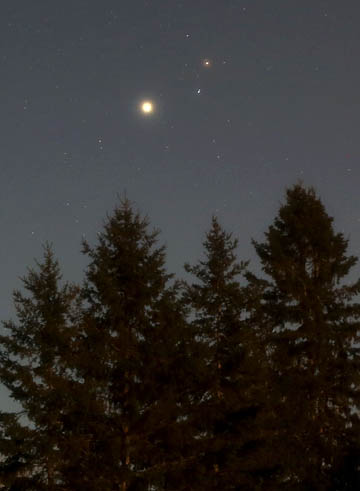
Bob King
If there's one thing good about subzero weather, it's usually accompanied by clear nights. We've had plenty the past two weeks, so Moon and morning planet gazing have been fantastic. Dress for it and limit your time out to a half hour, and you'll thrive. Late sunrises make it relatively easy to get up for a look before breakfast. I'll wake up at 6:30, finish observing around 7:15, then have tea and breakfast. Astronomy, yes, that genteel pursuit.
Here's hoping the cold continues, because 2018 opens with one of the year's best and closest conjunctions. Mars, hurrying east in the months before its opposition this summer, will practically crash into Jupiter (visually at least!) on the mornings of January 6–7. Watch for the Red Planet to slide only about 17 arcminutes — less than ⅓° — south of Jove on both dates. East Coast observers will see an 18′ minimum on January 6th, while Hawaiian skywatchers will see the pair a little tighter at 14′ that morning. The next morning will feature nearly identical separations with Mars to the east of Jupiter.
Shining at magnitude –1.8, Jupiter will clearly dominate this conjunction. Mars has been slowly brightening these past months but only manages magnitude 1.4. For the best view, I'd recommend watching the pair in early twilight at the first blush of blue in the southeastern sky, when they'll still stand out against the darker sky background. This is also a good time to photograph the event — the dawn blue plus moonlight will make for a richly colored backdrop.
I like to use a 35- or 50-mm lens to include a scene. More sky around the two planets better matches the visual impression, too. With your camera on a tripod and the ISO set to 800, expose between 6 and 10 seconds. I'll also use a gentle diffusion filter to soften and "expand" the brighter stars and planets so they stand out apart from the fainter stuff. I hand-hold the filter in front of the lens for about a third of the exposure time or 10 seconds during a 30-second exposure.
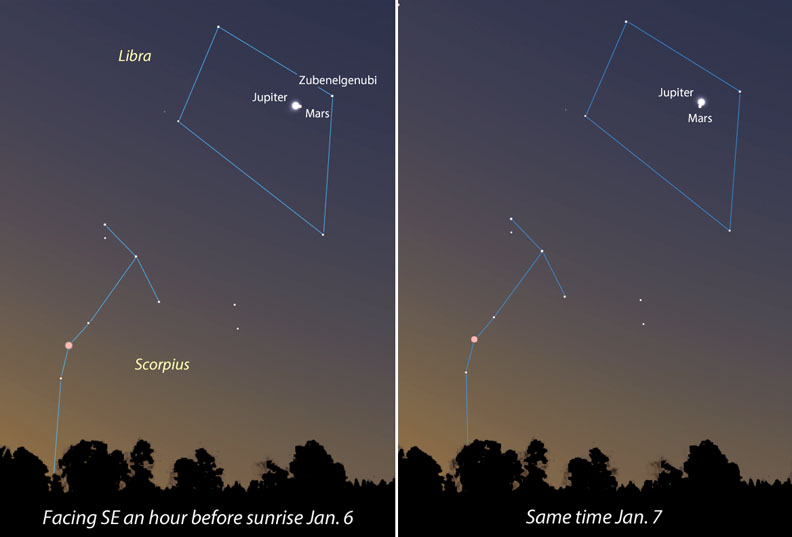
Stellarium
Conjunctions show off nature's phenomenal jewelry-making abilities. Even people who don't ordinarily watch the sky are dazzled by the sight of two bright planets close together. I like watching them approach each other and then part like bumper cars in slow motion. If you have a telescope, you can enjoy the conjunction on an entirely different level. Jupiter and Mars will shine in the same field of view at low and medium magnifications, giving us the chance to appreciate each planet's size and character.
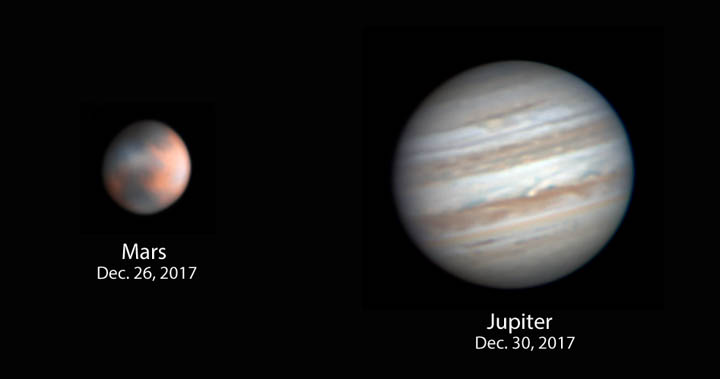
Damian Peach — Chilescope Team (left) / Anthony Wesley
Low magnifications of 50-70× will show the big planet's north and south equatorial belts, but you'll need at least 250× to detect any trace of Mars's dark albedo features. The drumstick-shaped Sinus Meridiani is currently in good view at dawn from North America; next week, fang-shaped Syrtis Major, one of the darkest, most easily identifiable features on Mars, will take center stage. The run-up to opposition is the best time to hone your planetary observing skills. Whatever feature is difficult to discern now will seem easy come July. That includes the north polar cap, also in view, but painfully small.
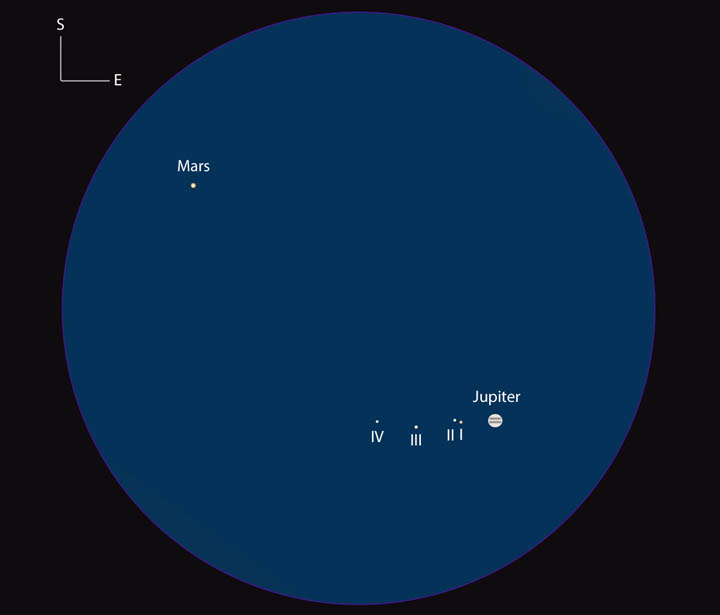
Stellarium
On both Saturday and Sunday mornings, all four Jovian satellites will fan out on either side of Jupiter, and even the Great Red Spot (GRS) will make an appearance. It crosses the planet's central meridian at 14:52 UT (best for the western half of North America) on the 6th and 10:43 UT (best for the eastern third) on the 7th. Subtract 5 hours from these times for Eastern Standard, 6 for Central, 7 for Mountain, and 8 for Pacific. Good viewing of the GRS can be had for about an hour either side of meridian crossing.
We can even use Jupiter's dominance to spot Mars through a telescope well into morning twilight or even after sunrise. I'm looking forward to a stellar coincidence. Not quite 3° to the west of the double-planet shines Alpha (α) Librae (Zubenelgenubi), Libra's brightest star and a wide double with magnitudes 2.7 and 5.1 separated by 4′. Located 77 light-years away, their true distance apart is nearly 140 times Pluto's distance from the Sun, or about 5,500 a.u.
On the morning of the 7th, both the Jupiter–Mars combo and Zubenelgenubi's companions will have approximately the same position angle (northwest-southeast) and fit comfortably in the same binocular field. Call it a double-double, call it jewelry, but be sure to head out and see it for yourself.
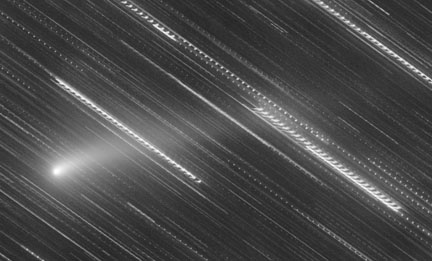
Gianluca Masi / Michael Schwartz
** A heads up for comet watchers! With the Moon now out of the early evening sky, you'll want to look for Comet Heinze (C/2017 T1) the next few nights. The comet passes closest to Earth on January 4th as it speeds across Camelopardalis and Cassiopeia. It's currently magnitude 10 and sports a faint dust tail. Here's a detailed finder chart (stars to mag. 8) to help you track it.
 17
17









Comments
Graham-Wolf
January 3, 2018 at 9:12 pm
Thanks, Bob, for the "heads up" on this.
Only 2 more sleeps to go.
Hopefully, the Weather Gods will oblige on the big day.
My own cup of post-conjunctional Tea will be will be two bags, easy on the milk and no-sugar, in a large plastic mug, with foam-rubber insulating wrap-round exoskeleton.
Fingers are also crossed for the Total Lunar Eclipse on the 31st, UT.
At this rate, I'll soon be riddled with metacarpal arthritis.
Looks like Ibuprofen (NSAID) time!
Graham W. Wolf at 46 South, Dunedin, NZ
You must be logged in to post a comment.
Bob KingPost Author
January 5, 2018 at 6:43 pm
Graham,
I like a little honey with mine. Us astro types risk arthritis from all that finger-crossing! Good luck and clear skies.
You must be logged in to post a comment.
Alexander Vasenin
January 5, 2018 at 5:57 pm
I always wondered how do they get the bright bright stars so prominent in photos. Diffusion filter it is. Thanks for the answer! Which one do you use btw?
You must be logged in to post a comment.
Bob KingPost Author
January 5, 2018 at 11:28 pm
Hi Alexander,
I use a Cokin Diffuser 2 A 84.
You must be logged in to post a comment.
Alexander Vasenin
January 7, 2018 at 1:16 am
I managed to see them just 13' apart this morning despite almost perpetual clouds. They were really beautiful in my 15x50s
You must be logged in to post a comment.
Tom-Reiland
January 6, 2018 at 2:06 pm
I was able to observe Mars, Jupiter and the 4 Galilean Moons this morning through my 5" f/5 Jaegar's Refractor at 31X. It was at least 0 deg F on my driveway at 5:15 this morning. Still not the coldest temperature that I ever observed. Twice I went out in -6 deg conditions, but not for very long. Plus, I was at least 30 years younger. Once for Halley's Comet in early March of 1986. January is my least favorite month to observe. I have fewer nights and hours than any month of the year, including February. Bring on the warm weather ASAP!
You must be logged in to post a comment.
Bob KingPost Author
January 7, 2018 at 10:48 am
Happy to hear you saw it, Tom. Thanks to all the bitter cold weather we've had here, it remained clear all week including the morning of closest conjunction Saturday. Temp. was -18 F Saturday morning but there was no wind, which really helped. I took a few photos and then brought out the scope. Seeing was excellent, and the planets and and moon were fantastic. Mars is a little small! Just saw the gibbous phase.
You must be logged in to post a comment.
Tom-Reiland
January 7, 2018 at 4:10 pm
Got another view of the pair of planets this morning using the method that Graham mentioned and I call "Window Observing." I used my 10 X 50s to see them again. The most amazing part of this first 6 nights of January is that all of them have had observable periods with four of them Clear to Mostly Clear. Last January we only had one Mostly Clear night for the whole month. We have averaged 19 degrees below normal per day for the last two weeks. It was -3 this morning.
You must be logged in to post a comment.
Graham-Wolf
January 6, 2018 at 8:23 pm
Hi Bob.
SUCCESS...
Saw the Mars and Jupiter conjunction early this morning... NZDT!
Weather bucketed down at midnight.... went to bed at 1:30am in disgust,
then woke up again at 3:28am.
Looked out my bedroom window from bed, and saw the conjunction on the upper edge of an emrging NE cloudbank, coming inland from the Pacific.
OMG!
Jumped out of bed, grabbed my 10x25 Binocs (6.5 df), and pressed them up to the window (in the famous style of the late (UK legend) George Alcock. Could easily split the planets, which were arranged exactly as predicted, even if upside down with respect to your "northern" maps. Mars was the redder but fainter of the two. Sadly, modest aperture and magnification did prevent my seeing the Galilean Moons themselves.
When Mars reaches opposition in August, it will really blaze in the sky, and be similar to ~ 2003!
After ~ 90s, the clouds quickly claimed the two planets, but I DID get to see it.
Nice Gibbous Moon noticed to the left.... the 3 will join up in just a few days.
Now......bring on that 31st January Total Lunar Eclipse!
(This just might be my redemption year).
Graham W. Wolf at 46 South, Dunedin, NZ
.
You must be logged in to post a comment.
Bob KingPost Author
January 7, 2018 at 10:49 am
Graham,
Your story is one of the reasons I love astronomy. You never know when it's going to turn into an adventure. Love the reference to Alcock and his binocular discovery from a warm kitchen. Cool that you remembered.
You must be logged in to post a comment.
Graham-Wolf
January 7, 2018 at 7:59 pm
Yep, Bob...
You could say that I "Alcocked" the conjunction!
Astronomy at times can certainly be quite a adventure.
An all-night clear sky is NOT a certainty... you have to use what "scraps" nature gives you.
George was quite a wonderful character... he just did things "his way", 'cause it worked.
I can hear Frank Sinatra singing George's praises in the back-ground!
"Old school" style, with quite a bit of Patrick on the inside, as well.
If I'd bothered to get dressed, let alone grab a scope, let alone go outside, I would have missed the whole darned thing, the other morning. As it was, I only got ~ 90s, but that was enough.The 10x25s were on my bedroom table:- just metres away, so I simply "went for it"!
When's there's precious little time to waste, you vertainly have to be quick on your feet.
Enjoyed naked eye views a couple of hours ago of the Last Quarter Moon lazily drooping on down over the local Western horizon (Mt Grand reservoir summit ridge). Pointed it out to a few local public, and reminded them of the Total Lunar Eclipse later this month. Weather Gods had better be nice to me!
Graham W. Wolf at 46 South, Dunedin, NZ.
You must be logged in to post a comment.
Bob KingPost Author
January 7, 2018 at 10:45 pm
Graham and Tom,
I "Alcocked" it. Graham, you are a genius.
You must be logged in to post a comment.
January 8, 2018 at 7:51 am
Lot of cloudy weather in the parts of Scandinavia where I live. Decided to travel to the Canary islands for a week and Enjoy warmer climate with my wife and guide her to the heavens. The "dynamic duo" were seen high up in a clear sky on the morning of 7th and 8th. Lower but very easy (compared to home) Mercury and Saturn twinkled. Nice to see our neighbours in space. Jakob
You must be logged in to post a comment.
Graham-Wolf
January 8, 2018 at 9:31 pm
Hi Bob.
Woke up this morning ~5am local time (NZDT), in strong dawn twilight.
Clear skies which went gradually hazy within 2 hours, and overcast with ~10,000 feet ceiling by 2pm.
That was an hour and a half ago.
Mars and Jupiter have definitely drifted a little further apart, and a (now) Last Quarter Moon has also travelled quite a bit closer to them both. The big "triple" coming to a morning sky near you... in just a few more days. Now, this is more like it.
Bring on that Lunar Total Eclipse on the 31st!
Weather Gods... you'd better behave!!
Graham W. Wolf at 46 South, Dunedin, NZ.
You must be logged in to post a comment.
Graham-Wolf
January 8, 2018 at 9:42 pm
Hi Jakob
Well done, sighting Mercury and Saturn!
I did actually notice them this morning, very low down in the East, over the Pacific coastline, here at Dunedin. Yep, I cheated a little , by running a "preview"simulation via Stellarium Android on my quadcore Alcatel PIXIE-4 Quad-core smart-phone.Visually, it was precisely as predicted.
This was a little before the emerging sun-rise "swallowed" them both up.
Mercury is usually a lot brighter than Saturn..... and there's no mistaking those awesome rings on the latter. Just wanted to acknowledge your own efforts. Keep it up.
Hope you had a great time in the Canaries and got to see the WHT, INT, and Kapteyn 'scopes.
I understand Dr Brain May completed his PhD thesis using data/observations from the WHT.
4.2m is quite a lot of aperture!!
Graham at 46 South, Dunedin, NZ
You must be logged in to post a comment.
January 9, 2018 at 1:41 pm
Thanks Graham. I am visiting Gran Canaria. Next time will be the island of La Palma and the observatories! Wish you clear skyes ahead. Regards from the northern latitudes. Jakob
You must be logged in to post a comment.
Graham-Wolf
January 9, 2018 at 7:37 pm
Hi Jakob
Thanks for the reply.
You should just be able to see the Magellanic Clouds etc, from the Canaries.... Brian (May) did a study of these for his PhD, after Queen folded when Freddie died. He actually joined Queen with Freddie as an astrophysics undergraduate, and was able to finish his degree much later.
The Crescent Moon, Jupiter and Mars all line up in a visual "trifecta" in a couple of days, Jakob.... the Moon being some 24% illuminated on that date. And on January 31st (UT), (Feb 1st down here at 46 South for me!), we get the Total Lunar Eclipse. I'm sure Bob will have much more to write about that, nearer the big day.
Enjoy your time down near the equator... the Southern Stars are quite fantastic.
Scandanavia is (of course) famous for the Aurora Borealis.... down here at 46 South, we frequently get the Australis (southern) version... visible almost overhead.
Graham at 46 South, Dunedin, NZ.
You must be logged in to post a comment.
You must be logged in to post a comment.